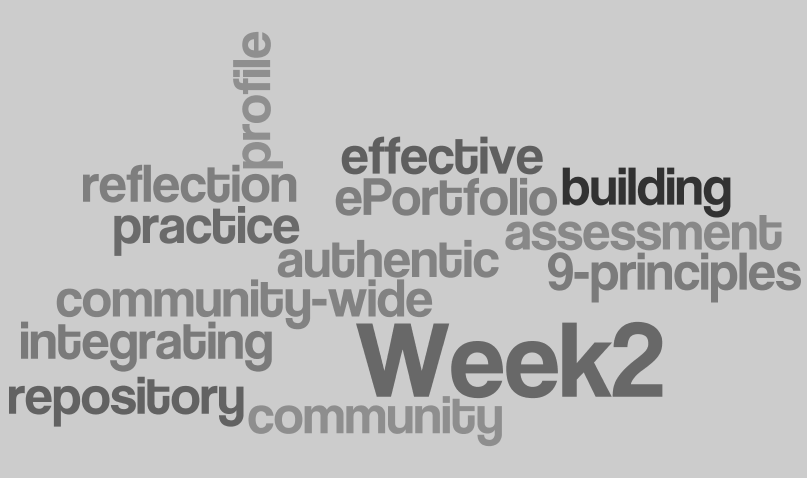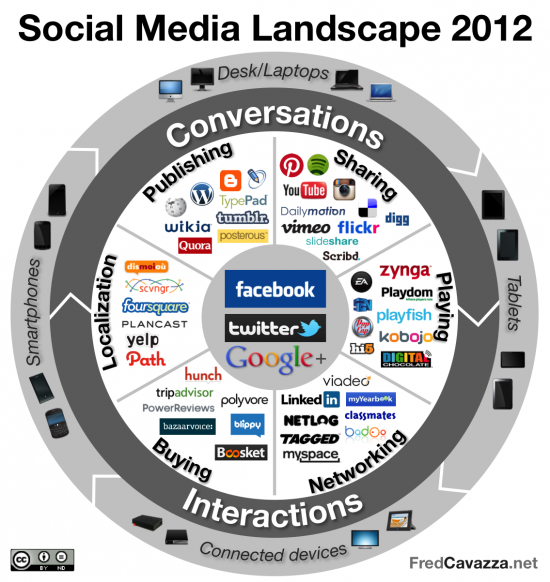Week 2: Developing an ePortfolio and Building Community
Week 2: Developing an ePortfolio and Building Community

Intro to Week 2
Audio Transcript
During week 2, you will create and begin to develop an ePortfolio and a plan of action for integrating authentic assessment into practice. Elements and stages of ePortfolio development are introduced and you will prepare a personal profile and design an outline for your ePortfolio. You will begin capturing your understanding and ongoing reflection on the key principles and concepts of effective authentic learning and assessment practice in technology-enabled learning environments. Finally, as a class, we begin the development of a community-wide repository that will used throughout the course to capture key ideas, suggestions, and resources related to authentic learning and assessment.
Learning Outcomes for this week
2. Apply key concepts of a learner-centered approach to the design of learning and assessment activities in courses.
3. Communicates effectively in selected media and modes.
4. Use technology to develop and support effective authentic learning and assessment practices.
7. Develop a plan of action for integrating authentic assessment into practice.
Resources
Required
Palloff and Pratt (2009) – pp. 100-103 - portfolios as assessment tools
Lorenzo and Ittelson (2005) - brief case studies of assessment ePortfolios used in higher ed.
Mueller (2008) - all about portfolios from the Authentic Assessment Toolbox site
Spotlight on faculty.
Watch this short interview with Maggi Feehan, as she talks about the portfolio assignment used as a capstone project in the Professional Communications Program at Royal Roads University.
Week 2 Activities
Activity 3: Creating an ePortfolio - Start by reading Assignment 5, including the 4 steps for creating an ePortfolio and the ePortfolio container requirements. The container you choose for your ePorfolio must support the assignment requirements. There are a wide variety of containers available, so it will be important to do some research on which container is right for you. For this activity, you will choose an ePortfolio container, prepare an outline and develop a personal profile. Please see Palloff and Pratt for an understanding of the different portfolio types and their use in assessment, then review the case studies in Lorenzo and Ittelson on uses in higher education. Next, use the section on portfolios in Mueller's Authentic Assessment Toolbox site to help you prepare your outline. Finally, prepare an outline in a format of your choice (e.g., document, mindmap, text, sketch) that includes:
- Audience
- Purpose
- The types of artifacts the ePortfolio will contain
- How you will organize the artifacts - by content type, projects, dates, headings etc.
- The container you have chosen
Activity 3 Forum: Post your ePortfolio outline in a new thread; review and comment on at least one other outline.
![]() Build your ePortfolio: After receiving feedback on your outline, start building the structure for your ePortfolio. Add your profile to your ePortfolio site. Your portfolio is private until you make it public in week 12. However, you can choose to make it visible at anytime and ask for peer feedback at different stages of development. The ePortfolio is an ongoing project, not something to be thrown together in the last week. It is important to add artifacts to it each week and while you work through the assignments. Then in week 12, you will choose the artifacts to best demonstrate your learning in this course.
Build your ePortfolio: After receiving feedback on your outline, start building the structure for your ePortfolio. Add your profile to your ePortfolio site. Your portfolio is private until you make it public in week 12. However, you can choose to make it visible at anytime and ask for peer feedback at different stages of development. The ePortfolio is an ongoing project, not something to be thrown together in the last week. It is important to add artifacts to it each week and while you work through the assignments. Then in week 12, you will choose the artifacts to best demonstrate your learning in this course.
Activity 4: Community-wide Repository - Over the next six weeks you will be working a scenario (individually, in pairs and as a class) to build a resource rich, community-wide repository. The repository will house the products of the first three assignments and will be a resource used when completing assignment 4. Pieces of the repository will also find their way into your ePortfolio. Use the class wiki to brainstorm a community profile and choose a home for the repository. Steps to complete activity 4:
- Review the scenario provided in the class wiki
- Develop a community profile for the repository that will guide the work you complete for assignments 1, 2 and 3
- Who are we as a community? – start with the scenario and expand it
- What are the goals of the repository?
- Who is it for? Could be the class participants or a different audience, e.g., college educators in Alberta, administrators in SD62.
- As a class come to consensus as to who you are as a community and finalize your community profile by end of week 2
- Research online repositories for social communities. Here are some potential online tools: Ning, Pinterest, Learnist, Facebook. And here are some example repositories: wikipedia, edutopia, Merlot, SOL*R. The repository needs to be editable and available to your audience and must support a variety of artifacts (e.g., text, video, audio, slides, images, social interaction, blogs, etc.). Working as a class come to consensus on a home for the repository. Have the repository ready for use at beginning of week 3. You will using it in assignment 1.
![]() Journal - two entries for week 2:
Journal - two entries for week 2:
- Post your ePortfolio personal profile & outline and consider the ways you could use portfolios in your own practice outside of this course. Also, reflect on the ways that an e-portfolio can serve as a means to support authentic learning and assessment.
- Reflect on the brainstorming process undertaken by the class. how was it organized, did one or more people take the lead?
